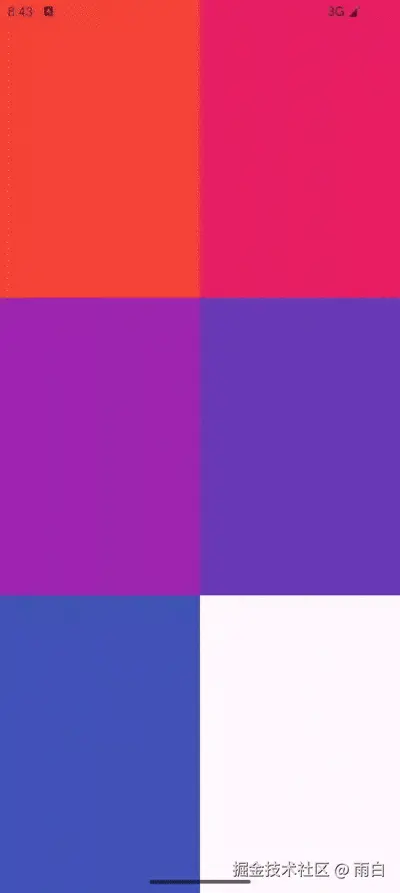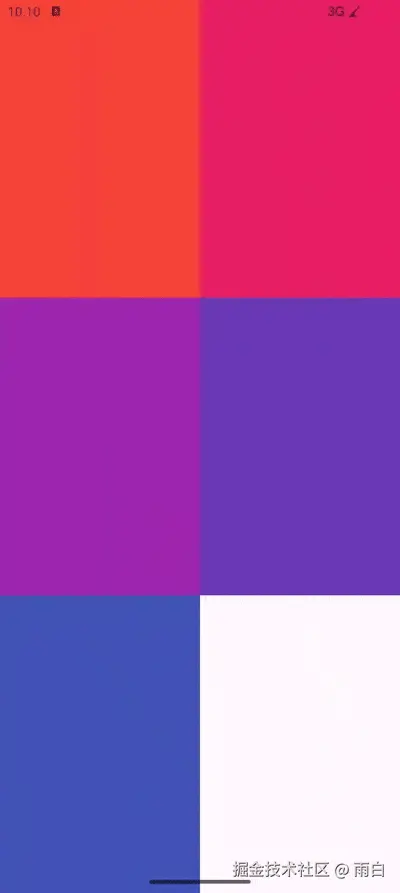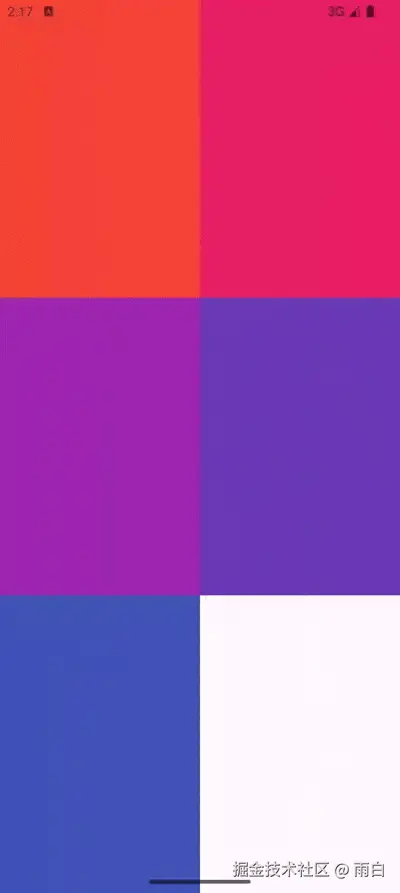前言
Android 提供了两种拖拽 API,分别是 ViewDragHelper 和 OnDragListener。
OnDragListener
我们先看第二种 OnDragListener,代码如下:
kotlin
class DragListenerView(context: Context, attrs: AttributeSet) : ViewGroup(context, attrs) {
private var columns = 0
private var rows = 0
private val dragListener = OnDragListener { v, event ->
when (event.action) {
// 拖拽开始
DragEvent.ACTION_DRAG_STARTED -> {
if (event.localState === v) {
v.visibility = INVISIBLE
}
}
// 拖拽进入某个View的区域,初始拖拽时也会触发,因为初始进入了被拖拽的View的区域
DragEvent.ACTION_DRAG_ENTERED -> {
if (event.localState !== v) {
// 此时 v 为拖拽进入的目标view
sortChildView(v)
}
}
// 拖拽离开某个View的区域
DragEvent.ACTION_DRAG_EXITED -> {
}
// 拖拽结束
DragEvent.ACTION_DRAG_ENDED -> {
if (event.localState === v) {
v.visibility = VISIBLE
}
}
}
true
}
private var draggedView: View? = null
private var orderedChildView: MutableList<View> = mutableListOf()
override fun onMeasure(widthMeasureSpec: Int, heightMeasureSpec: Int) {
columns = 2
rows = childCount / columns + 1
val widthSpec = MeasureSpec.getSize(widthMeasureSpec)
val heightSpec = MeasureSpec.getSize(heightMeasureSpec)
val childWidthMeasureSpec =
MeasureSpec.makeMeasureSpec(widthSpec / columns, MeasureSpec.EXACTLY)
val childHeightMeasureSpec =
MeasureSpec.makeMeasureSpec(heightSpec / rows, MeasureSpec.EXACTLY)
measureChildren(childWidthMeasureSpec, childHeightMeasureSpec)
setMeasuredDimension(widthSpec, heightSpec)
}
override fun onLayout(
changed: Boolean,
l: Int,
t: Int,
r: Int,
b: Int,
) {
for (i in 0 until childCount) {
val child = getChildAt(i)
child.layout(
0,
0,
child.measuredWidth,
child.measuredHeight
)
child.translationX = (i % columns * child.measuredWidth).toFloat()
child.translationY = (i / columns * child.measuredHeight).toFloat()
}
}
override fun onFinishInflate() {
super.onFinishInflate()
for (i in 0 until childCount) {
val child = getChildAt(i)
orderedChildView.add(child)
child.setOnLongClickListener { v ->
draggedView = v
v.startDragAndDrop(null, DragShadowBuilder(v), v, 0)
true
}
child.setOnDragListener(dragListener)
}
}
fun sortChildView(targetView: View) {
// 重新排序View列表
var targetViewIndex = 0
var draggedViewIndex = 0
orderedChildView.forEachIndexed { index, view ->
if (view === targetView) {
targetViewIndex = index
}
if (view === draggedView) {
draggedViewIndex = index
}
}
swapElements(orderedChildView, targetViewIndex, draggedViewIndex)
// 使用动画重新布局
for (i in 0 until orderedChildView.size) {
val child = orderedChildView[i]
val x = (i % columns * child.measuredWidth).toFloat()
val y = (i / columns * child.measuredHeight).toFloat()
child.animate()
.translationX(x)
.translationY(y)
.setDuration(300)
.start()
}
}
private fun swapElements(list: MutableList<View>, index1: Int, index2: Int) {
val temp = list[index1]
list[index1] = list[index2]
list[index2] = temp
}
}布局代码:
xml
<?xml version="1.0" encoding="utf-8"?>
<com.example.dragview.DragListenerView xmlns:android="http://schemas.android.com/apk/res/android"
android:id="@+id/main"
android:layout_width="match_parent"
android:layout_height="match_parent">
<View
android:layout_width="wrap_content"
android:layout_height="wrap_content"
android:background="#F44336" />
<View
android:layout_width="wrap_content"
android:layout_height="wrap_content"
android:background="#E91E63" />
<View
android:layout_width="wrap_content"
android:layout_height="wrap_content"
android:background="#9C27B0" />
<View
android:layout_width="wrap_content"
android:layout_height="wrap_content"
android:background="#673AB7" />
<View
android:layout_width="wrap_content"
android:layout_height="wrap_content"
android:background="#3F51B5" />
</com.example.dragview.DragListenerView>运行效果:

我们来讲解一下是如何实现的。
首先,对每个子 View 进行测量和布局。
kotlin
// onLayout 方法中
for (i in 0 until childCount) {
val child = getChildAt(i)
child.layout(
0,
0,
child.measuredWidth,
child.measuredHeight
)
child.translationX = (i % columns * child.measuredWidth).toFloat()
child.translationY = (i / columns * child.measuredHeight).toFloat()
}在布局过程中,我们先调用 layout 方法将每个子 View 摆放在了 (0,0) 位置,然后再使用 translationX/Y 移动子 View 到对应的位置。
这是为了让动画过程更简单,动画时,只需考虑移动后的位置,而无需关心初始的位置和移动前的位置。
kotlin
// onFinishInflate 方法中
for (i in 0 until childCount) {
val child = getChildAt(i)
orderedChildView.add(child)
child.setOnLongClickListener { v ->
draggedView = v
v.startDragAndDrop(null, DragShadowBuilder(v), v, 0)
true // 表示消费长按事件
}
child.setOnDragListener(dragListener)
}然后在布局加载完成、视图都创建好后,我们为每一个子 View 设置了长按监听器。在长按时,会调用子 View 的 View.startDragAndDrop 方法,开始拖拽。
设置了拖拽监听器,在拖拽时,能够回调 OnDragListener.onDrag 方法。
还将每个 View 放入 orderedChildView 列表中,以便后续使用。在长按回调中,更新了当前被拖拽的 View。
kotlin
private val dragListener = OnDragListener { v, event ->
when (event.action) {
DragEvent.ACTION_DRAG_STARTED -> {
if (event.localState === v) {
v.visibility = INVISIBLE
}
}
DragEvent.ACTION_DRAG_ENTERED -> {
if (event.localState !== v) {
sortChildView(v)
}
}
DragEvent.ACTION_DRAG_EXITED -> {
}
DragEvent.ACTION_DRAG_ENDED -> {
if (event.localState === v) {
v.visibility = VISIBLE
}
}
}
true
}在拖拽过程中,每个注册了的子 View 都会收到拖拽的回调。
其中 localState 就是开始拖拽时传入的数据,也就是 startDragAndDrop 方法的第三个参数 myLocalState,就是当前正在被拖拽的 View,这个数据我们可以随时拿取。
此方法的第一个参数 ClipData data 也可以传递数据,但它只能在释放了被拖拽的数据后才能拿取,在 DragEvent.ACTION_DROP 事件中。
我们让正在被拖拽的 View 在开始拖拽时隐藏,在拖拽结束后显示。每当拖拽进某个 View 的区域时,我们就调用 sortChildView 方法,以动画的形式重排每个 View 的位置。
kotlin
fun sortChildView(targetView: View) {
// 获取目标View和被拖拽View的索引
var targetViewIndex = 0
var draggedViewIndex = 0
orderedChildView.forEachIndexed { index, view ->
if (view === targetView) {
targetViewIndex = index
}
if (view === draggedView) {
draggedViewIndex = index
}
}
// 交换两个元素
swapElements(orderedChildView, targetViewIndex, draggedViewIndex)
// 使用动画重新布局
for (i in 0 until orderedChildView.size) {
val child = orderedChildView[i]
val x = (i % columns * child.measuredWidth).toFloat()
val y = (i / columns * child.measuredHeight).toFloat()
child.animate()
.translationX(x)
.translationY(y)
.setDuration(300)
}
}如果拖拽时并不隐藏,运行效果将会是:

为什么拖起来的是半透明的,原来的东西还在?
这是因为 startDragAndDrop 方法启动的是系统级的拖拽。我们拖动的并不是一个 View,而是一个影子,它被绘制在了最顶层,能够遮挡住状态栏、导航栏,甚至其他应用。
系统只关心这个影子和要传递的数据,并不管原来的 View 是否存在。所以,我们需要手动在 ACTION_DRAG_STARTED 中将 View 隐藏,在 ACTION_DRAG_ENDED 中显示。
ViewDragHelper
再来看第一种 ViewDragHelper,完整代码:
kotlin
class DragHelperView(context: Context, attrs: AttributeSet?) : ViewGroup(context, attrs) {
private var viewDragHelper = ViewDragHelper.create(this, DragHelperCallback())
inner class DragHelperCallback : ViewDragHelper.Callback() {
override fun tryCaptureView(
child: View,
pointerId: Int,
): Boolean {
return true
}
override fun onViewDragStateChanged(state: Int) {
if (state == ViewDragHelper.STATE_IDLE) {
val capturedView = viewDragHelper.capturedView
capturedView?.elevation--
}
}
override fun clampViewPositionHorizontal(
child: View,
left: Int,
dx: Int,
): Int {
return left
}
override fun clampViewPositionVertical(
child: View,
top: Int,
dy: Int,
): Int {
return top
}
var capturedLeft = 0f
var capturedTop = 0f
override fun onViewCaptured(capturedChild: View, activePointerId: Int) {
capturedChild.elevation = elevation + 1
capturedLeft = capturedChild.left.toFloat()
capturedTop = capturedChild.top.toFloat()
}
override fun onViewPositionChanged(
changedView: View,
left: Int,
top: Int,
dx: Int,
dy: Int,
) {
}
override fun onViewReleased(
releasedChild: View,
xvel: Float,
yvel: Float,
) {
viewDragHelper.settleCapturedViewAt(capturedLeft.toInt(), capturedTop.toInt())
postInvalidateOnAnimation()
}
}
override fun computeScroll() {
if (viewDragHelper.continueSettling(true)) {
ViewCompat.postInvalidateOnAnimation(this)
}
}
// 行列数
private var columns: Int = 0
private var rows: Int = 0
override fun onMeasure(widthMeasureSpec: Int, heightMeasureSpec: Int) {
columns = 2
rows = childCount / columns + 1
val widthSpec = MeasureSpec.getSize(widthMeasureSpec)
val heightSpec = MeasureSpec.getSize(heightMeasureSpec)
val childWidthMeasureSpec =
MeasureSpec.makeMeasureSpec(widthSpec / columns, MeasureSpec.EXACTLY)
val childHeightMeasureSpec =
MeasureSpec.makeMeasureSpec(heightSpec / rows, MeasureSpec.EXACTLY)
measureChildren(childWidthMeasureSpec, childHeightMeasureSpec)
setMeasuredDimension(widthSpec, heightSpec)
}
override fun onLayout(
changed: Boolean,
l: Int,
t: Int,
r: Int,
b: Int,
) {
for (i in 0 until childCount) {
val child = getChildAt(i)
child.layout(
i % columns * child.measuredWidth,
i / columns * child.measuredHeight,
i % columns * child.measuredWidth + child.measuredWidth,
i / columns * child.measuredHeight + child.measuredHeight
)
}
}
override fun onInterceptTouchEvent(ev: MotionEvent): Boolean {
return viewDragHelper.shouldInterceptTouchEvent(ev)
}
override fun onTouchEvent(event: MotionEvent): Boolean {
viewDragHelper.processTouchEvent(event)
return true
}
}运行效果:

会发现在手指触碰的瞬间,就开始了拖拽。并且拖拽开始后,子 View 不是半透明的,还会被状态栏、导航栏挡住(图中没展示出来)。
和刚才的不一样,为什么呢?
因为 ViewDragHelper 不是系统级的拖拽功能,只是一个辅助工具(Helper)。
我们用它来拖动 View 本身,它在实时地修改 View 的 left 和 top 坐标,所以这个 View 还在它原来的父布局里中,自然会被父布局裁剪、被状态栏挡住,也不是半透明的。
讲解一下实现方式。
kotlin
private var viewDragHelper = ViewDragHelper.create(this, DragHelperCallback())
override fun onInterceptTouchEvent(ev: MotionEvent): Boolean {
return viewDragHelper.shouldInterceptTouchEvent(ev)
}
override fun onTouchEvent(event: MotionEvent): Boolean {
viewDragHelper.processTouchEvent(event)
return true
}首先,我们创建了 ViewDragHelper 对象,然后让它去判断是否拦截和处理事件。必须要在这两个方法中将事件交给它,这样才能正常工作。
我们再来看各个回调方法,首先是 tryCaptureView。
它会在手指触摸到子 View 的一瞬间被调用,询问是否抓住这个 View。如果返回 true,子 View 就会跟着手指移动,否则,不移动。
kotlin
override fun clampViewPositionHorizontal(
child: View,
left: Int,
dx: Int,
): Int {
return left
}
override fun clampViewPositionVertical(
child: View,
top: Int,
dy: Int,
): Int {
return top
}这两个回调用于限制移动的范围,这里并没有限制,因为总是返回内部计算出的建议位置。如果返回 0,就无法拖动子 View。
kotlin
var capturedLeft = 0f
var capturedTop = 0f
override fun onViewCaptured(capturedChild: View, activePointerId: Int) {
capturedChild.elevation = elevation + 1
capturedLeft = capturedChild.left.toFloat()
capturedTop = capturedChild.top.toFloat()
}当子 View 被拖拽时,会被调用,我们将该 View 的层级加一,让它可以显示在最前方。并保存了初始位置,以便后续能够吸附回原来的位置。
kotlin
override fun onViewPositionChanged(
changedView: View,
left: Int,
top: Int,
dx: Int,
dy: Int,
) {
}被拖拽的子 View 位置改变时会调用此方法,你可以在这实现拖拽重排的功能。
kotlin
override fun onViewReleased(
releasedChild: View,
xvel: Float,
yvel: Float,
) {
viewDragHelper.settleCapturedViewAt(capturedLeft.toInt(), capturedTop.toInt())
postInvalidateOnAnimation()
}这个是松手的回调,我们调用 settleCapturedViewAt 方法让被拖拽的 View 回到之前的位置,然后调用了 postInvalidateOnAnimation() 进行重绘。
kotlin
override fun computeScroll() {
if (viewDragHelper.continueSettling(true)) {
ViewCompat.postInvalidateOnAnimation(this)
}
}重绘时会调用 computeScroll 方法,我们调用 continueSettling() 方法检查 View 是否在移动过程中,如果在,就继续触发重绘,直到 View 回到原本位置。
最后,在回到空闲状态时,需要降低层级。
kotlin
override fun onViewDragStateChanged(state: Int) {
if (state == ViewDragHelper.STATE_IDLE) {
val capturedView = viewDragHelper.capturedView
capturedView?.elevation--
}
}这些回调方法就讲解完毕了。
最后,为了防止同时拖拽多个子 View,可以添加一个标记。
kotlin
var isDragging = false
override fun tryCaptureView(
child: View,
pointerId: Int,
): Boolean {
return !isDragging
}
override fun onViewDragStateChanged(state: Int) {
if (state == ViewDragHelper.STATE_IDLE) {
isDragging = false
// ...
}
}
override fun onViewCaptured(capturedChild: View, activePointerId: Int) {
isDragging = true
// ...
}实际应该怎么选?
在 OnDragListener 中,我们说到开始拖拽时传递数据的方式有 data 和 myLocalState 参数,它们可用的时机不同。
为什么要这么设计?
其实 data 数据 (类型为 ClipData,剪贴板数据),它是可以跨进程的。我们可以拖动图片或是文字到另一个应用中。
所以 OnDragListener 主要关注的是拖起、放下动作以及数据的传递,并不关心 View 的移动,只关心数据从 A 移动到了 B。它拖动的半透明影子是全局的,所以可以跨应用,盖住所有东西。
而 ViewDragHelper 关注的是界面中的子 View 的拖动,它会修改子 View 的坐标。比如侧滑菜单(DrawerLayout)、底部弹窗(BottomSheet),都是通过它来实现的。
总结:
-
要做跨应用、传数据的拖拽,就使用
OnDragListener。 -
要在自定义 ViewGroup 中,实现子 View 拖动或滑动控制,就使用
ViewDragHelper。